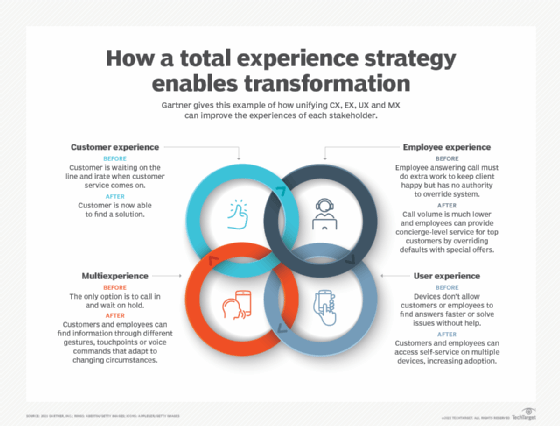
Getty Images
The value of a total experience platform
Combining customer, employee, omnichannel and multichannel, and UX platforms and tools into a total experience offering improves visibility, metrics and insights.
Customers purchasing a product or service or receiving sales and support use multiple touchpoints and interact with numerous digital services and customer service agents. Platforms such as CX, employee experience, omnichannel and multichannel, and UX are great ways to track various metrics and provide actionable information to streamline processes.
However, these platforms are often built and managed as independent systems with no data sharing among them. This creates visibility gaps that hinder a business's ability to take the customer journey to a new level. Let's learn about what a total experience platform is, which currently siloed offerings are combined to create a TX platform, and what the benefits and challenges of a total experience strategy are.
What is a total experience platform?
Instead of looking at individual experience tools and attempting to manually stitch together their separate metrics and insights in a cohesive way, TX platforms provide a holistic approach that pulls in experience data from multiple sources and digital tools. This delivers unified insights and measurements that automatically link various experiences together to achieve improved efficiencies and increase customer journey satisfaction across the organization.
What is combined in a total experience platform?
TX platforms merge several previously segregated experience platforms together to create a unified offering that improves the customer journey, while supporting employees in improving their ability to promote and win over more customers.
A total experience strategy proposes that much of the data found in each of these independent solutions is interconnected to provide further insights and strategy opportunities that would otherwise not be visible.
CX
CX platforms are software-based systems that monitor and track the customer journey. With a focus on customer perceptions of a business's brand, a number of metrics and KPIs are collected and analyzed to deliver a roadmap on how to improve satisfaction and help drive the sales process. Data collection occurs across the following customer touchpoints:
- Advertisement interactions.
- Marketing campaign engagement.
- Social media posts.
- Online reviews.
- Customer feedback surveys.
- Website views and clicks.
- Point-of-sale locations, times and rates.
- Sales, customer service and contact center interactions.
- Quotes, invoices and returns.
Once the data is collected and analyzed, CX teams identify various pain points and inefficiencies that can be used to improve and refine customer journey processes.

Employee experience
Commonly managed by the HR department, employee experience platforms focus on identifying aspects of internal employee touchpoints to improve social, physical and cultural workplace aspects of the business. In many cases, employees interact directly with customers, so meeting their needs helps improve their ability to create ideal customer experiences.
Because of the growing shift toward digital transformation, the technologies employees interact with become a key part of keeping them engaged. This helps them perform their duties, including working with customers, as they research, evaluate, purchase and seek customer support for the products and services they purchase. The goal is to create a working environment that lets employees meet customer expectations and provide them with avenues to make improvements to increase satisfaction.
Omnichannel and multichannel experience
Businesses need to implement touchpoints that help customers research and purchase products and services and interact with customer service. Multichannel and omnichannel strategies consolidate the management, data collection and performance analysis of these touchpoints across digital and nondigital mediums. This includes visibility across websites, social media, mobile apps, chat and contact/call centers.
The goal of multichannel is to create consistent CX that also lets customers be categorized into various groups based on their personal preferences. From here, groups can be targeted with specialized advertising and marketing through the customer journey touchpoints they will likely interact with the most.
UX
The way customers interact with and engage with products and services is known as UX. This platform works to get into the mind of various customer groups so that the appropriate customer touchpoints can be provided to them more efficiently. Much like CX, UX pulls in information related to customers and their experiences with digital and nondigital touchpoints to see where processes can be streamlined that help facilitate improved engagement and decrease the sales cycle time frame.
Benefits and challenges of a total experience strategy
As mentioned, total experience strategies take a holistic approach to experiences across customers, employees and technologies to better improve the customer journey process. It works across these previously siloed disciplines to identify areas of overlap where improvements can be made.
The problem that many organizations initially discover is that existing CX, employee experience, multichannel experience and UX offerings don't integrate well with each other. In many cases, this requires a significant overhaul of existing technologies and employee-focused processes to create a unified system.
A significant investment in total experience technologies is required to break down data collection and analysis barriers. Additionally, great care must be taken to ensure both customer and employee data privacy is being adhered to. While this process requires integration, cultural and process rework investments, research conducted by Gartner stated that "organizations providing a total experience will outperform competitors by 25% in satisfaction metrics for both CX and [employee experience]." This is a substantial performance improvement that can significantly affect a business's ability to sell more products and build lifelong brand loyalty.
Andrew Froehlich is founder of InfraMomentum, an enterprise IT research and analyst firm, and president of West Gate Networks, an IT consulting company. He has been involved in enterprise IT for more than 20 years.







